May 2008 MGA visit to the Lagerstätten of South-West Germany
WOW! What a week!! 1117 kilometres, 7 museums, 4 quarries, 1 meteorite crater, a trip on the Rhine (15 minutes ) and a cable car ride, plus a lot of cream cakes and sausages, all in 7 days. We were 7 MGA members led by Dr John Nudds (Manchester University) and Dr Cindy Howells (Cardiff Museum ) all in a big mini bus going to look at 4 sites of exceptional fossil preservation.
Mary Howie
Members' experiences:-
Saturday 17th May 2008: Darmstadt - Tourism
Our party of nine met at 8 am at Manchester Airport, where John Nudds provided us with a superb illustrated booklet which detailed our plans for the week.
In Darmstadt we visited the Mathildenhöhe, an Artists’ Colony, which was designed for an exhibition in 1901 in the Jugendstil or Art Nouveau style. We admired the gold-decorated Russian chapel, went up the Wedding Tower for a view over the town, and wandered amongst lots of outdoor art including large stone sculptures and pollarded plane trees. Coffee and cake featured here for the first but not the last time and we tried out our non-existent German language skills.
We then drove to the Rosenhöhe and strolled in the rose gardens and flower meadows.
No geology today, but a very pleasant and relaxing introduction to Germany for those of us who had not been there previously.
Sue Plumb
Sunday 18 th May 2008: Grube Messel - Eocene Oil Shale - 49 Ma
After a good night’s sleep at the friendly, family run Schnecken-Schroeder Hotel, a very early start was made by John and Mike who went for a run through the woods. Fortified with an excellent breakfast, we all headed off to the Messel Pit where Dr Mike Walker gave us a stimulating 3 hour tour of the pit, explaining the history and the many fortunate circumstances which enabled this area to be designated a World Heritage Site yielding a continuing supply of Eocene fossils. A rare combination of circumstances 49 million years ago allowed the preservation soft tissue in a range of fossils. The steep sides of the pit prevented the animals from getting out and anoxic bottom water prevented decomposition.
Until recently the accumulated oil shale was mined to produce oil. Plans to use the pit as a refuse dump were vigorously opposed, but only after vital water pumping had been installed, this meant the pit was left in good condition as a continuing source of fossils. The fossils are very fragile and need to be kept wet until they can be prepared and encased in resin. Recent deep boring has confirmed the origin of the site as a Maar volcano followed by sedimentation. The bore also provided an artesian well providing 8,000 year old water for Dr Nudds et al to sample!

We had a typical German Sunday lunch in Messel village before visiting the nearby Messel museum to view the pit’s fossils including plants, insects, amphibians, birds, bats, horses, fish and reptiles. The pit’s most famous fossils are the ancient horses. One of the species, Propaleotherium parvulum had a shoulder height of only about 30cm and was a browser of leaves and seeds, existing at a time before the establishment of grasslands. The day’s outing was rounded off with ice cream and a walk round a nearby lake then beer on the hotel terrace and another sensational supper at the hotel.
Michael and Joyce Cunningham
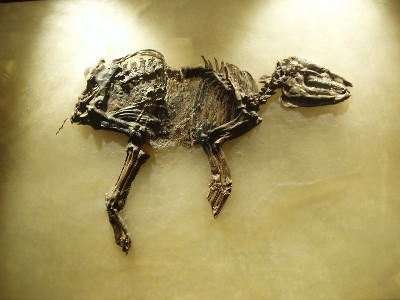
Monday 19th May: Rothenburg ob der Tauber, Nördlingen & the Ries Crater - 50 Ma
Monday was a traveling and sightseeing day as all museums are closed. We drove to Rothenberg, and arrived in the market square of this mediaeval walled town as the clock in the Rathaus struck twelve and the little windows each side flew open to reveal the Mayor downing 3 litres of wine watched by Count Tilly!
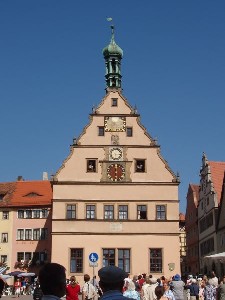
After lunch and a wander round the town we went on to Nördlingen, another walled town, in the Ries impact crater. Here we climbed the tower of St Georg Kirche, seven storeys high, for a wonderful panorama and a close study of the impact brecchia, the suevite of which the tower is built.

Refreshed with cakes and tea we moved on to Otting where, in a disused quarry, Mary’s hammer was put to good use chipping out samples of suevite. Finally we reached Eichstätt and rounded off a busy day with an excellent meal at the Ammonite Restaurant.
Bess Barry
Tuesday 25th May: Eichstätt and Solenhofen - Upper Jurassic Limestone - 150 Ma
No, we didn’t find Archaeopteryx number 11, but we did see 4 real specimens and casts of most of the rest at the 2 museums we visited.
First, the Jura museum, housed in the Willibaldsberg Schloss, Bishop Willibald’s summer palace, built high above the Altmuhl valley.
Here were wonderful specimens from the Solenhofen Plattenkalk all beautifully preserved in the honey-coloured, lithographic limestone. Ferocious fish, huge crocodiles, horseshoe crabs, insects….. So many.. and of course a couple of real Archeoopteryxs or is it Archeoopteryxi.
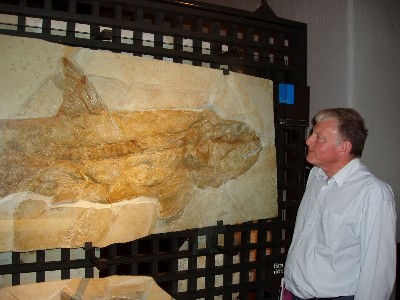
No time for coffee, but off up the Altmuhl valley, past huge limestone bluffs composed of sponge remains, to the Burgermeister Müller museum, more Archeopteryxi, crabs and fish.
Upstairs was an exhibition of the old printing process when the polished Solenhofen limestone was used as the basis for the first lithography, today it is quarried for flooring and wall cladding.
Lunch was taken on the terrace of the Alte Schule Gasthof, more sausages, sauerkraut, bread and beer with a lovely view over the valley.
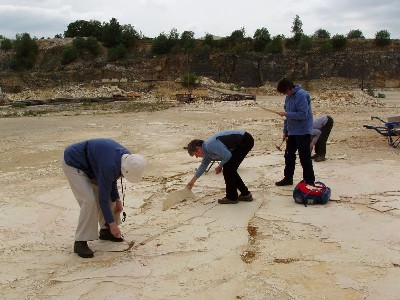
Then, armed with hammers and chisels, hired from the museum, we were off to the Haardt quarry (where the first Archeopteryx were found) … hoping for Archy number 11. No, sadly no luck, but we found 3 small fish, some floating crinoids and bits of ammonites. Grubby, but happy, we drove back to Eichstätt for Kaffee and Kuchen.
Mary Howie
Wednesday 25th May: Holzmaden and Ohmden Quarry - Lower Jurrassic Shales - 180 Ma
We drove to Holzmaden to visit the Hauff Museum. Bernard Hauff Snr brought Holzmaden to the attention of the scientific world in 1892 when he exposed the outline of the body of a fossil ichthyosaur complete with its skin. The preservation of the soft tissue in Hauff’s specimen proved the presence of a triangular dorsal fin and an upper lobe to the tail, neither of which had skeletal support and which were previously unknown. The museum is now managed by Rolf Hauff, grandson of Bernard Hauff Snr.
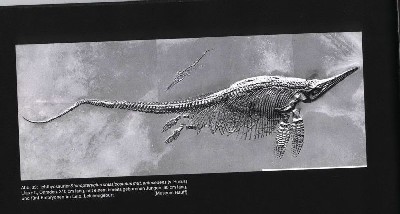
The geology in this area is the Lower Jurassic, Upper Lias, Holzmaden shales, which extends over a depth of only about 6 metres. There is a stunning display in the museum where this sequence of the Holzmaden Shale is laid out as a series of large shallow steps, with each level featuring large characteristic fossils in situ. There are also many excellent fossils on display including icthyosaurs, plesiosaurs, crocodiles, turtles, fish, ammonites, belemnites, pterodactyls, and a 12 metre long sea lily or crinoid attached to a floating log, which is well displayed on the wall of one gallery.
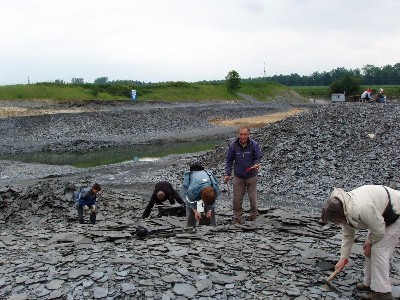
In the afternoon we drove to Ohmden quarry and, armed with hammers and chisels, attempted to find our own specimens. The Wilderschiefer beds near the top of the Holzmaden shales are exposed here and these contain many pyritised ammonites. The quarry was full of families on school holidays who were hammering merrily away, with none of the health and safety concerns which are usually prevalent in these situations in the UK We all found plenty of ammonites and so became rather blasé about them by the end of the afternoon.
Sue Plumb
Thursday 22nd May: Stuttgart Museums
On Thursday we travelled to the very fine Löwentor Museum Stuttgart. This houses a beautiful collection from the Devonian to the Pleistocene including specimens from each site we had visited. A notable specimen was the skull of the Placodont Cyamadus roatratus, a marine reptile of the Triassic. This has simple tablet teeth in the upper jaw suitable for crushing thick shells of molluscs & brachiopods. On through the galleries past pregnant Ichthyosaurs, Woolly Mammoths, Primeval Horses and much more: for sheer elegance a huge Crinoid display dominated two storeys of wall. A comprehensive collection with many favourites. Still reeling from such a plethora and fortified with coffee and kuchen, a walk through charming parkland led to the Natural History Museum in the Rosenstein palace.
Then off to Bad Kreuznach, a spa town full of holidaymakers enjoying the Corpus Christi national holiday.
Barbara Hey
Friday 23rd May: The Hunsrück Devonian Slates - 390 Ma
Our final day was spent in the beautiful Hunsruck Mountains visiting the Herrenberg Slate Mine, where our museum guide greeted us with the Miners’ daily greeting of “Gluck Auf” (Good Luck) before showing us round the second level of this old mine. After viewing the old workings of vertical slates, we were then invited to view the adjacent museum, which houses a small, but fine collection of Herrenberg fossils: - starfish, brittle-stars, fishes, etc.
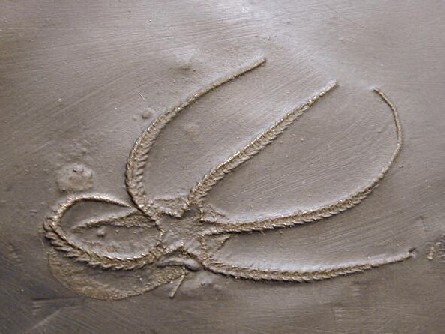
A leisurely lunch at the museum was followed by a practical session of fossil preparation led by a local palaeontologist, Wouter Sudkamp, in which we all laboriously scraped away at locally collected slates to slowly reveal our very own Devonian fossils beautifully preserved in pyrites.

Wouter then escorted us to his house, where, following a virtuoso demonstration of how to round off slates for roofing, he showed us his fine collection of fossils, mostly from the Hunsruck, which included some type and figured specimens.
Jim Spencer
Saturday 24th May: Home via Rüdesheim am Rhine
Having failed to organise a wine tasting, I thought that at least we could see the vineyards and the bends in the river. So we encouraged John to drive to the car ferry across the Rhine and we had our 15 minute boat trip to Rüdesheim am Rhine, another very touristy medieval village. Today it was heaving with Harley Davidson bikers….. hundreds of them having a Bike Fest! We escaped up the cable car, swinging over the vines, to the huge Germania monument, celebrating the victory over the French in 1871, had our last cup of Kaffee mit Kuchen, then off to Frankfurt airport and home.
On the way back John asked me which was the best bit - I couldn’t answer.. It was all great - 4 fantastic Lagerstätten, fossil hunting in quarries, fossil preparation, amazing fossils in fantastic museums, medieval walled towns, plus a crater and some superb suevite: a great week with very congenial companions!
Mary Howie
PS John Nudds and Paul Selden are talking about a trip to the American Lagerstätten next summer.. I’ll keep you informed MDH
If you want to know more about the Geology - read Paul and John’s super book :- Evolution of Fossil Ecosystems (2004), by Selden & Nudds ISBN 1-8476-041-9
www.mansonpublishing.com/sci_titles/SeldenNudds.html
**************************************










